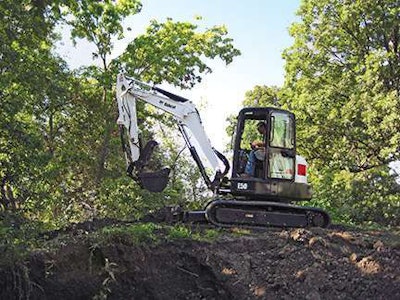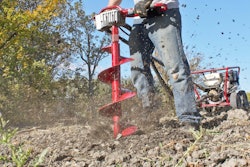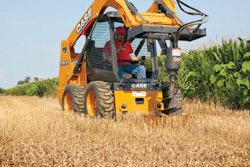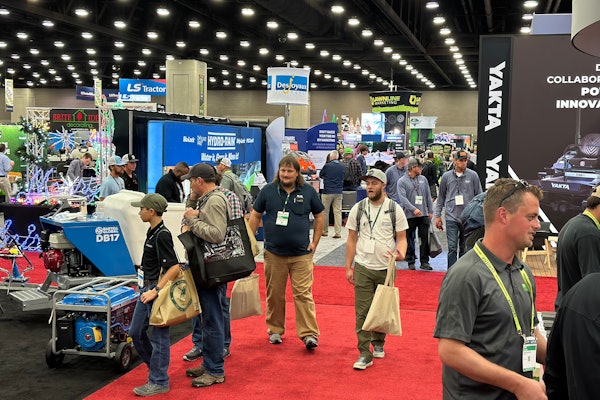
Your compact excavator offers remarkable utility far beyond its conventional role. Here are 10 applications you probably didn’t know you could perform with a compact excavator, according to Tom Connor, Bobcat excavator specialist.
1. Clearing — In wooded or overgrown areas targeted for development, compact excavators can improve properties with their ability to level dead or fallen trees and remove underbrush. Their tracks help to provide access through thick vegetation and soft terrain. Versatile attachments like midsize buckets with teeth, three-tined grapples and rotating grapples can grab, pull and drag saplings and rooted undergrowth, as well as sort and load material.
2. Park maintenance — All of the landscaping jobs performed for residential or commercial properties are typically needed in municipal and federal park maintenance. Buckets and grapples assist with cleaning and clearing land and building campsites. Clamps move broken concrete, brush, logs, tree stumps, boulders and other odd-shaped objects — even old playground equipment. Grading blades make great tools for rough or finish grading, backfilling and leveling.
3. Trail development — Constructing and maintaining the trail systems and golf cart paths that are popular with recreational enthusiasts is tough to do with most machines, but is easier with a compact excavator equipped with a trenching bucket and grading blade. Excavators are ideal for clearing and prepping paths measuring approximately 5 feet wide with minimal disruption. These machines increase their value exponentially by eliminating the alternative of hand labor and shovels.
4. Landscaping/hardscaping — Anytime there’s a need to re-form land, recreate an outdoor environment, or build an elaborate hardscape, compact excavators with rotating grapples provide the grasp. The wrist-like flexibility of a rotating grapple allows operators to dig square holes, load/unload and sort material, move vegetation and place landscape boulders and timbers. Tined grapples, paired with a clamp attachment, are perfect solutions for handling timbers and other dimensional lumber for a hardscape project like construction of waterfalls and ponds.
5. Demolition — Excavators are perfectly suited to all phases of demolition work with attachments like breakers, buckets, grapples and clamps. Armed with these accessories, operators can tear out concrete and asphalt driveways, sidewalks, trails, paths and swimming pools. Knocking down small vertical structures such as old buildings and retaining walls into manageable chunks is possible, too.
6. Site prep/grading — Prepping a site for paving or planting could be done with your excavator fitted with a ripper to penetrate and scarify frost and hard ground. An appropriate bucket will haul in aggregate base material. Some manufacturers offer a tilt swing accessory that mounts between the excavator’s bucket and the arm to help create slopes, cut drainage ditches or contour soil. A grading blade can turn an excavator into a rough or finish grader, as well as a backfilling and leveling machine.
7. Compaction — An excavator can be fitted with a plate compactor that is designed to compress soil from the top down, while a packer wheel attachment can compact the fill from the bottom up. These two attachments can eliminate placing workers in a trench to do hand-operated compaction or managing a walk-behind unit above ground to close up a trench.
8. Utility rehabilitation — With their versatility and ability to access tight areas, compact excavators and attachments such as buckets, grapples, grading blades and clamps are as effective in utility rehabilitation applications as in new construction. With an aging infrastructure, there’s a growing need to refurbish aging utilities, specifically gas and sewer lines and septic tank systems. More municipalities are also realizing the aesthetic and protective value of burying overhead power lines.
9. Tree planting/fence posts — Fast and accurate digging with an auger provides operators a quick method for installing fence posts, piers and poles, or planting trees and other vegetation.
10. Reshaping earthen walls — With a growing emphasis on climate change and wet weather patterns, many urban and rural areas are seeing increased stress on dike and levee walls. With a grading bucket and an extendable arm available on some compact excavators, walls can be reshaped by pulling fallen dirt up to a levee’s top edge to re-form the shelf. The soil can then be rolled downhill and sloped with a swing accessory for improved mowing and spraying.


![Equip_opener_0513[2]](https://img.totallandscapecare.com/files/base/randallreilly/all/image/2013/04/tlc.Equip_opener_05132.png?auto=format%2Ccompress&fit=crop&h=167&q=70&w=250)






